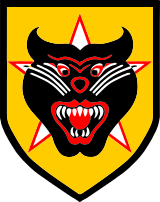ARVN Rangers
| Vietnamese Rangers | |
|---|---|

Shoulder sleeve insignia
|
|
| Active | 1951 – 1975 |
| Country |
|
| Branch |
|
| Type | Light infantry |
| Role |
Search and destroy Counter-insurgency |
| Size |
54 battalions (1975)
|
| Garrison/HQ |
Da Nang Nha Trang Khánh Hòa Song Mao Bình Thuận |
| Engagements | Vietnam War |
| Insignia | |
| Unit flag |  |
54 battalions (1975)
The Vietnamese Rangers, properly known in Vietnamese as the Biệt Động Quân, more commonly known as the ARVN Rangers, were the Rangers of the Army of the Republic of Vietnam. Trained and assisted by American Special Forces and Ranger advisers, the Vietnamese Rangers infiltrated beyond enemy lines in daring search and destroy missions. Initially trained as a counter-insurgency light infantry force by removing the fourth company each of the existing infantry battalions, they later expanded into a swing force capable of conventional as well as counter-insurgency operations.
The French established a commando school in Nha Trang in 1951. After the American Military Assistance Advisory Group took over the military advisory role, the school was converted to a Ranger school in 1956. In 1960, when the Vietnam War began in earnest, the Vietnamese Rangers were formed. Rangers (Biet Dong Quan [BDQ]) initially organized into separate companies with US Army Rangers were assigned as advisers, initially as members of the Mobile Training Teams (MTTs), at Ranger Training Centers (RTC), and later at the unit level as members of the Military Advisory Command Vietnam (MACV). A small number of Vietnamese Ranger officers were selected to attend the U.S. Army Ranger School at Ft. Benning.
In 1962, BDQ companies were initially formed into counter-insurgency Special Battalions but by 1963 Ranger units were organized into battalions and their mission evolved from counter-insurgency to light infantry operations. During 1966, the battalions were formed into task forces, and five Ranger Group headquarters were created at corps level to provide command and control for tactical operations. The Ranger Group structure was maintained until 1970 as U.S. force reduction commenced. The Civilian Irregular Defense Group (CIDG) situated along the Laotian and Cambodian borders, formerly under control of 5th U.S. Special Forces Group, was integrated into the Ranger command. Thus, the Rangers assumed an expanded role of border defense. The conversion of CIDG camps to 37 combat battalions with 14,534 men, more than doubled the Ranger force size. Within the early 1970s before the fall of Saigon, the rangers lost its appeal. Although many wanted to join the ranks of the Rangers, the popularity of the Airborne and Marine divisions grew at a faster rate.
...
Wikipedia
